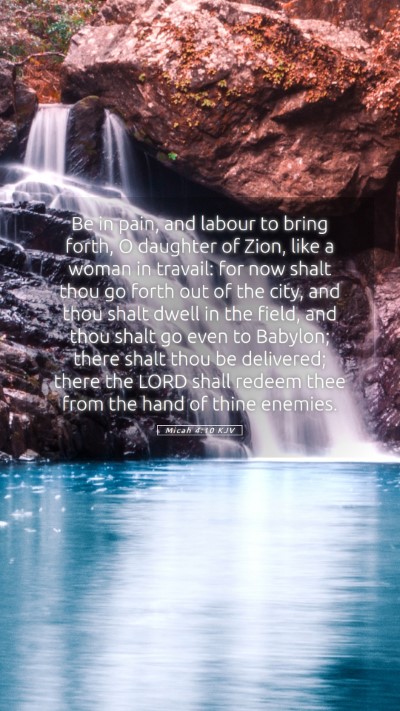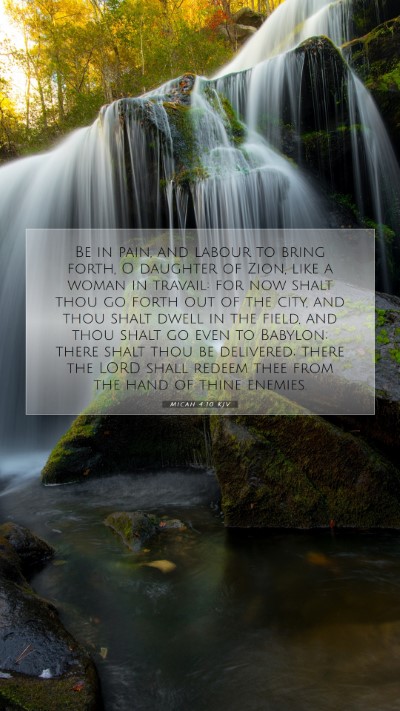Old Testament
Genesis Exodus Leviticus Numbers Deuteronomy Joshua Judges Ruth 1 Samuel 2 Samuel 1 Kings 2 Kings 1 Chronicles 2 Chronicles Ezra Nehemiah Esther Job Psalms Proverbs Ecclesiastes Song of Solomon Isaiah Jeremiah Lamentations Ezekiel Daniel Hosea Joel Amos Obadiah Jonah Micah Nahum Habakkuk Zephaniah Haggai Zechariah MalachiMicah 4:10 Meaning
What is the meaning of Micah 4:10?
Be in pain, and labour to bring forth, O daughter of Zion, like a woman in travail: for now shalt thou go forth out of the city, and thou shalt dwell in the field, and thou shalt go even to Babylon; there shalt thou be delivered; there the LORD shall redeem thee from the hand of thine enemies.
Micah 4:10 Bible Verse Meaning
Bible Verse Meaning: Micah 4:10
Verse: "Be in pain, and labour to bring forth, O daughter of Zion, like a woman in travail: for now shalt thou go forth out of the city, and thou shalt dwell in the field, and thou shalt go even to Babylon; there shalt thou be delivered; there the Lord shall redeem thee from the hand of thine enemies."
Understanding Micah 4:10
This verse from the book of Micah speaks of a profound message of pain and hope. It begins with a call for the "daughter of Zion" to be in pain as she brings forth something new. This metaphor is deeply rooted in the biblical context of childbirth, symbolizing the struggles and eventual deliverance that the people of Israel would experience.
Key Themes
- Expression of Distress: The imagery of a woman in travail illustrates the intense suffering that precedes the birth of something significant, contextualizing the struggles faced by Jerusalem and its people.
- Promise of Redemption: The latter part of the verse offers hope with the promise that the people will be delivered, indicating God's faithfulness in times of trouble.
- Historical Context: Micah prophesies during a time of impending foreign invasion and exile, specifically mentioning Babylon, which foreshadows the Babylonian captivity.
Insights from Public Domain Commentaries
Matthew Henry's Commentary: Henry focuses on the metaphor of labor pains, emphasizing that just as a mother experiences pain before joy, the people of Israel must endure suffering before their restoration. He notes the significance of the location change from the city to the fields and ultimately to Babylon, highlighting that God's plan transcends their immediate suffering.
Albert Barnes' Commentary: Barnes suggests that the deliverance mentioned goes beyond mere physical escape from Babylon; it encompasses a spiritual redemption. He points out that the phrase "there shalt thou be delivered" hints at a future hope, reinforcing the idea that God's redemptive power will prevail despite current hardships.
Adam Clarke's Commentary: Clarke expounds on the idea of the "daughter of Zion" representing the collective people of Israel and documents how their journey through suffering will ultimately lead to joy. He emphasizes that through their trials, they are being prepared for a greater purpose and restoration by God.
Application to Daily Life
Micah 4:10 provides a poignant lesson on the cycles of pain and hope in our lives. Many individuals experience phases of struggle that may seem insurmountable; however, like the promise given to Israel, believers are reminded that out of pain can come new beginnings. This verse encourages us to endure our hardships with the faith that God can turn our situations around, offering spiritual and emotional deliverance.
Cross References
- Isaiah 66:7-8: A parallel passage that speaks of the joy that follows the anguish of childbirth.
- Jeremiah 29:10: Offers a promise of restoration after exile.
- John 16:21: Jesus speaks about the joy that follows sorrow.
Conclusion
In summary, Micah 4:10 serves as a profound reminder of the interplay between suffering and redemption. As we delve deeper into this verse through various biblical exegesis methods, we gain insights not just into historical contexts but also into the timeless truths that resonate in our lives today. Through Bible study lessons, group discussions, and personal reflection, we can extract rich meanings from such verses that guide us on our spiritual journey.


